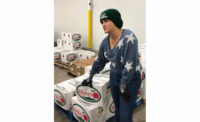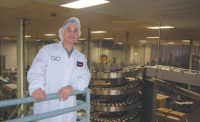The outside air contains many contaminants that, if allowed to land on a food item, can cause serious health risks. Mold, yeast and coliform bacteria are chief among these concerns.
“The outside world is full of microorganisms,” says Jim McConnell, plant manager for the Odom’s Tennessee Pride processing facility in Little Rock, Ark, “so you do the best you can to make sure you’re minimizing the influence of that inside the plant through the air system with refrigeration and filtration.”
Any meat processing plant has to be concerned with keeping the inside of the facility cool, so air conditioning is an important part of the plant. However, to control condensation, outside air must be brought in and mixed with the conditioned air. This outside air must pass through filters, to keep any contaminants or bacteria away from the food. McConnell, who has been with Odom’s for 14 years, notes that improvements in filtration have led to filters that can block anything larger than 10 microns in size.
Maintaining positive air flow is a key step of good air quality. If the air pressure in the building is higher than outside it, air will not blow into the facility through cracks or an open door. When a door is opened, air should blow out of the facility to keep any contaminants from being blown inside.
Good air quality is important in all parts of a facility, but especially in a ready-to-eat area inside a plant. Odom’s Little Rock facility cooks sausage patties, and McConnell says that the positive air flow inside the plant has to start from within the RTE area.
“When you have a ready-to-eat area, you want to make sure that you have more positive pressure than you would on the raw side, so you’re not bringing in the air from the raw side,” he says. “You’re pushing air out toward the raw side from the ready-to-eat area.” In his facility, which also has a slaughter area, the airflow moves from the RTE room to the raw area and then to the kill floor.
“That way, you’re not drawing air from the other direction, which can create a major problem,” he adds.
A slaughter area, like the one Odom’s has, can be a potential problem area, not just for the air quality inside the plant, but also the air outside of the plant. McConnell notes that the facility is right in the middle of Little Rock, surrounded by businesses, so it can’t he emitting any effluents into the surrounding area. To eliminate odors at the kill floor, McConnell says that employees wash and sanitize every part of that area every night.
Air testing
McConnell says that in order to verify that the air quality inside the plant is up to standards, Odom’s quality assurance group leaves air microbe plates throughout the plant. He recommends that all companies do frequent plate testing to make sure mold or yeast is not present in a plant.
“We put those out in the plant so we can monitor what our level of potential microorganisms are in the ambient air in the plant,” he says. “We do that on a weekly basis, and we chart it, graph it and meet on it every week.” With that testing and reporting method, the staff is able to quickly identify any areas where microorganisms are entering the building and make changes. It could just be something as an entry door seal needing replacement.
McConnell says that technology is helping companies improve air quality. Filters are able to trap smaller contaminants, and there are now washable filters for companies that don’t want to expense of continuously replacing them. Automated refrigeration systems can monitor the environment without employees trying to do that manually, and it can alert the operator via computer whenever something needs repair. He recommends that companies take a good look at the available equipment when replacing compressors and systems.
“Look at what’s available, new and better than what you had before you go and replace it with the same old thing. It’s not always best just to put the same old thing back in,” he says.




Report Abusive Comment